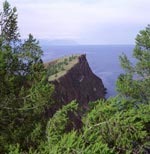About Baikal
Where is Lake Baikal?
 "This huge, old, beautiful lake, surrounded by wildness, is a
world treasure, a world heritage. But right now the world needs
to come to Lake Baikal's rescue."
"This huge, old, beautiful lake, surrounded by wildness, is a
world treasure, a world heritage. But right now the world needs
to come to Lake Baikal's rescue."
-- David Brower
This is the oldest and deepest lake in the world-recently
recognized as a World Heritage Site by the United Nations.
Situated in the southern steppes of Siberia, the lake is
surrounded by mountain chains that form sheer walls thousands of
feet high.
Indigenous people call Lake Baikal the "Sacred Sea" in
admiration of its majestic beauty and size. Blessed with ample
biodiversity, the lake itself provides habitat for more than 1,500
plant and animal species found nowhere else on earth. In fact, the
world's only freshwater seal lives here, in the amazingly clear
water of Baikal.
The main towns in the area are Severobaikalsk,
Babushkin,
Selenginsk, Baikalsk, Sludyanka. The territory of these five urban
centres are excluded from the World Heritage property.
Lake Baikal is much visited by local, national and
international tourists. There are several camping and tourists
bases on the Lake shore. The more inhabited southern and eastern
parts are better developed in terms of facilities and
infrastructure. The mountain ranges of the Eastern Sayans and
Barguzin attract climbers. Irkutsk and Ulan Ude provide
services and facilities for tourists and visitors (Ministry of
Environmental Protection, 1994b).
Why go to Baikal?
 Baikal holds twenty percent of the earth's fresh water and harbors
more endemic species of plants and animals than any other lake in
the world. Fed by 336 rivers and streams including the Angara,
Barguzin, Selenga, Turka and Snezhnaya, the lake holds fifty
species of fish including bullhead, sturgeon and omul.
Baikal holds twenty percent of the earth's fresh water and harbors
more endemic species of plants and animals than any other lake in
the world. Fed by 336 rivers and streams including the Angara,
Barguzin, Selenga, Turka and Snezhnaya, the lake holds fifty
species of fish including bullhead, sturgeon and omul.
The lake's surrounding wild mountains and rivers make the Lake
Baikal region an ideal area for engaging in an array of outdoor
pursuits including hiking, climbing, whitewater sports, skiing
and nature photography.
Climate
Comprises a continental climate with profound fluctuations of
both annual and daily temperatures. Mean daily temperatures range
from -25 C in January to 18 C in July. However, Lake Baikal itself
creates a microclimate within a 25km radius of its shores, distinct
from the terrestrial part of the basin. Winter temperatures are
less severe at -21 C, and summer temperatures are cooler (15 C).
The surface of the Lake freezes during winter, with ice present
until mid-June. The wind regime is comparable to those found in
coastal areas: in winter, winds blow from the relatively cold land
to the lake, and in summer, from the lake to the relatively warm
land (Galaziy, 1993).
|

